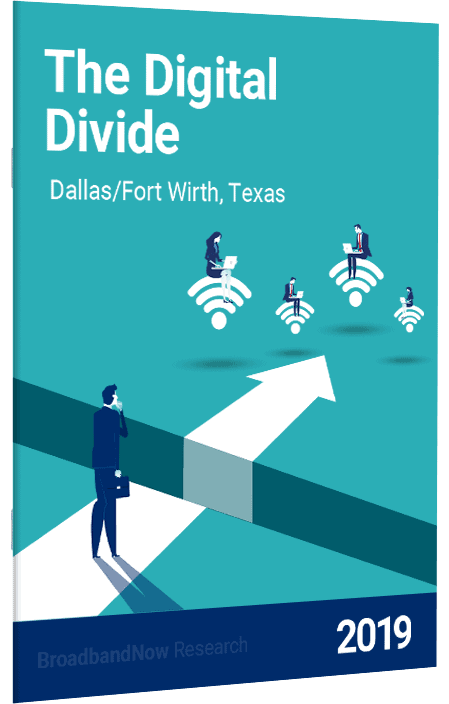In America, many major cities are well-connected to the internet, with residents having multiple high-speed options available to them. Yet, despite this, many suburbs and adjacent towns do not share in these benefits, often lacking even one low-cost, high-speed internet provider to choose from. In this report, we will seek to highlight these underserved areas in an effort to better measure the digital disparity between the various urban hubs of the DFW metroplex and their suburban counterparts.
Texas Internet Access At-A-Glance
- 89% of Texans have access to wired broadband.
- Only 57.7% of Texans currently have access to a low-cost broadband plan.
- The average download speed in Texas is currently 52.6 Mbps.
- Texas is the 31st most-connected state overall.
The DFW Digital Divide, Visualized
To add greater visibility to the regional divide in North Texas, we have mapped the areas in Dallas, Tarrant and Denton counties where wired broadband access exists against where affordable wired broadband access is, as defined below. Having access is only part of the equation – the digital divide can only be bridged when connectivity is affordable for consumers as well. For this report, we have defined “affordable wired broadband” as a stand-alone internet broadband speed plan that is $60 or less per month and “broadband” as speeds of at least 25 Mbps download and 3 Mbps upload, as defined by the FCC.
How to use our maps
Below, you will find several interactive maps of the Dallas/Fort Worth area. You can use the slider toggle to view the disparity between areas with access to wired broadband internet versus areas with access to affordable broadband.
The census block-level data underpinning these visualizations comes from a combination of provider’s FCC 477 filings and data we have received directly from providers. We considered all stand-alone internet plans meeting the minimum broadband speeds that were available in the areas shown.
Right of the slider displays Access to Affordable Wired Broadband
DFW County Breakdowns
As the combined county visualization above illustrates, there is a significant contrast in terms of broadband availability and pricing depending upon which area of DFW you examine. Below, we’ve taken a more granular approach, highlighting specific gaps in broadband access across the metroplex.
Dallas County
Right of the slider displays Access to Affordable Wired Broadband
Dallas is a well-connected city overall, with 96.9% of residents having access to a wired broadband provider offering at least 25 Mbps download speeds & 3 Mbps upload speeds. Despite this, as you can see, many areas both downtown and on the outskirts of the city lack access to an affordable broadband option. Large areas of Wilmer and Hutchins have no wired broadband services at all.
Tarrant County
Right of the slider displays Access to Affordable Wired Broadband
Fort Worth and Tarrant County as a whole are similar to Dallas county in many respects, with 92.7% of residents having access to wired broadband. Though the majority of the county has access to at least one broadband-level connection, many areas of Fort Worth, Forest Hill, Primrose, White Settlement, and others lack affordable options for internet service.
Denton County
Right of the slider displays Access to Affordable Wired Broadband
The mid-sized city of Denton is well-connected, with 95.2% of residents having access to broadband-level internet connections. That said, areas just a few miles further north see a significant drop-off in both access and low-cost options. Whitesboro, Krum, Sanger, Ponder, and Pilot Point are all rural communities with extremely scant access to affordable options for broadband service.
Further Reading
- The State of Broadband in America, Q2 2019
- Digital divide: broadband pricing by state, zip code, and income level
- Elon Musk & Jeff Bezos Can Save American Households $30+ Billion with LEO Satellites
- Municipal Broadband Is Roadblocked Or Outlawed In 26 States
Local non-profits
There are hundreds of organizations spread out across the United States that are working to close the digital divide and allow every single American to be a part of our collective digital future. Here are a few Texas-based organizations doing excellent work in the state:
- Broadband Planning Initiatives
- USFon
About our Data
Data for this study comes from current publicly available plan data of Texas providers. We defined broadband internet as a residential provider plan with at least 25Mbps download and 3Mbps upload speeds and wired broadband as cable, fiber, and DSL technologies. Coverage is based on what providers have reported on their most recent FCC Form 477, or to us manually, at the census block level. If a provider has indicated that they have coverage in census block, we assume that all of the provider’s plans are also available in that given block. Plan pricing is based on the regular monthly rate offered. Promotional rates are only considered if that is the only advertised price publicly available and local-only deals are not considered.

